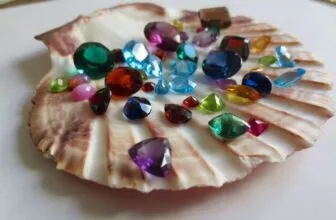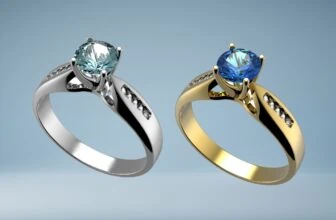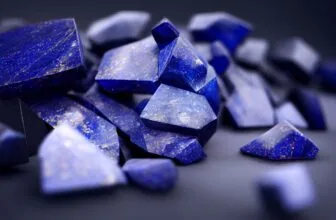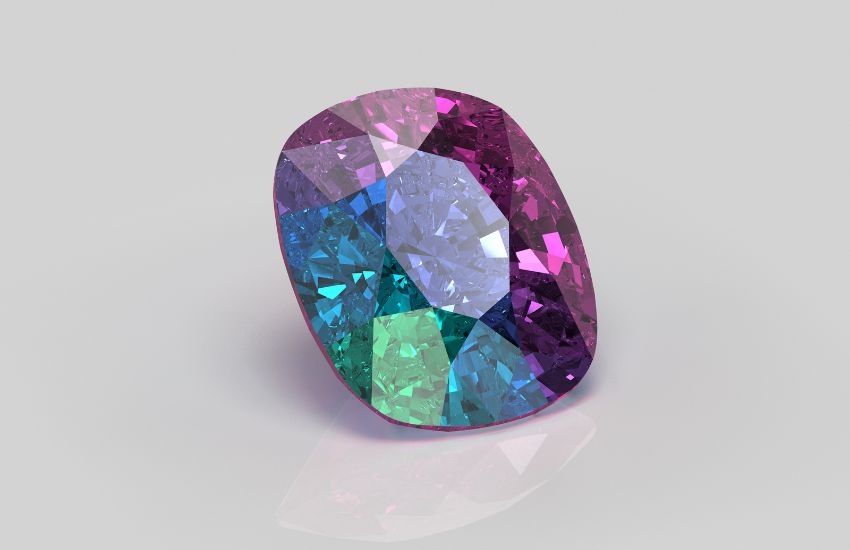
Table of Contents
Alexandrite stands out in the world of gemstones for its rare color-changing ability, shifting from green in daylight to red under artificial light. This unique characteristic, along with its scarcity and intriguing history, makes alexandrite a highly sought-after and valued gem.
Let’s explore the origins, properties, and significance of alexandrite. We’ll also take a look at why it’s so prized among collectors and jewelry enthusiasts.
What is Alexandrite?
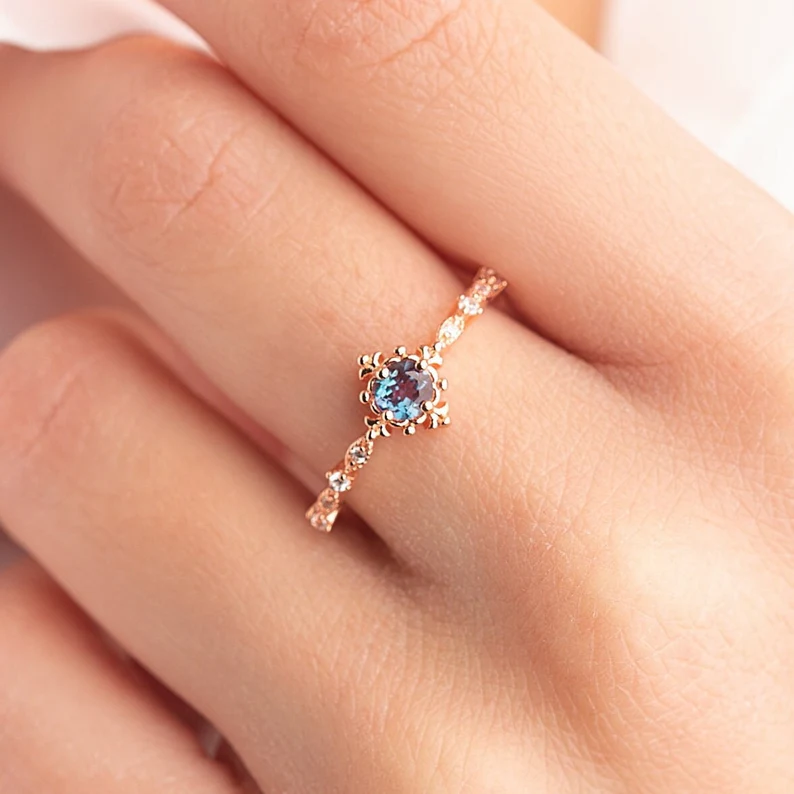
Alexandrite, a rare gemstone, is famous for its ability to change color. This gem is a type of chrysoberyl, made up of beryllium, aluminum, and oxygen. Its standout feature is changing from green in daylight or fluorescent light to reddish or purplish under incandescent light, due to trace elements like iron, titanium, and chromium in its structure.
Found in Russia’s Ural Mountains in the 1830s, alexandrite got its name from Alexander II, the future Tsar of Russia. Its discovery holds historical significance because its colors, red and green, were the same as Imperial Russia’s military colors.
On the Mohs scale, alexandrite scores 8.5, making it hard and suitable for jewelry. However, its scarcity makes it expensive. While the original Russian deposits are mostly depleted, new sources in Brazil, Sri Lanka, and East Africa have emerged, though their color change is typically less vivid than the Russian ones.
Alexandrite is also believed to have metaphysical qualities, thought to bring balance, boost self-esteem, and inspire creativity. Its rarity and unique color-changing feature have made it a valuable and sought-after gemstone among collectors and jewelry lovers.
Origin and History of Alexandrite
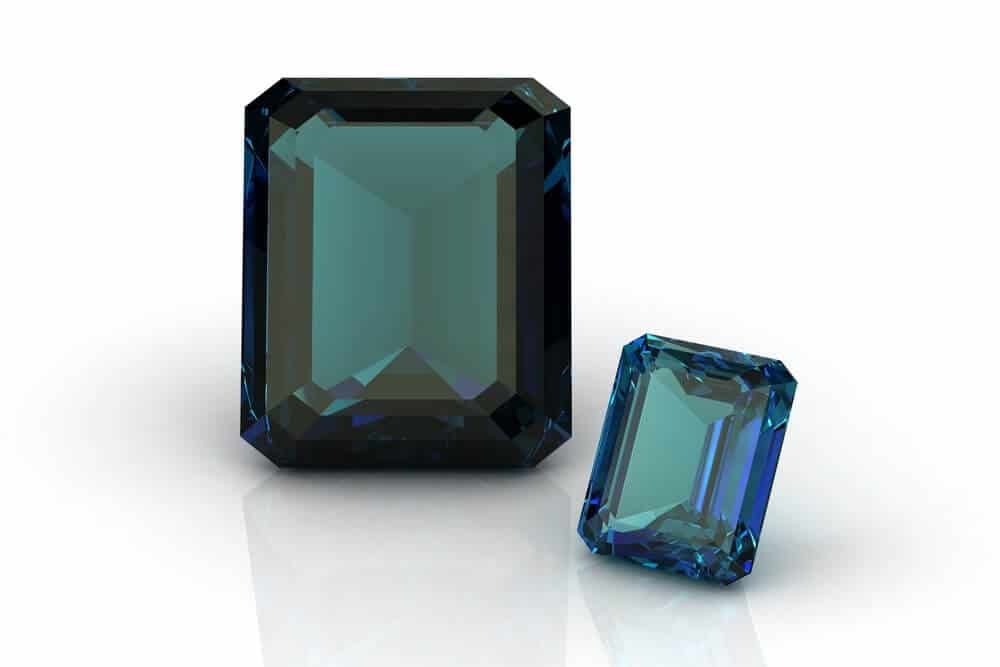
Alexandrite emerged in the 1830s in Russia’s Ural Mountains, specifically in emerald mines near the Tokovaya River. Its discovery, coinciding with the birthday of future Tsar Alexander II, inspired its naming.
The gemstone quickly gained national prominence due to its unique color-changing ability and because its colors, red and green, matched Imperial Russia’s military colors, making it a symbol of national pride.
This period in Russia was marked by notable social and political shifts, which further integrated alexandrite into Russia’s cultural identity. As the original Russian alexandrite sources dwindled, new deposits surfaced in Brazil, Sri Lanka, and East Africa.
However, these newer sources often yield stones with less distinct color changes compared to the Russian ones. The scarcity of alexandrite with dramatic color shifts has enhanced its allure and value, solidifying its status as a coveted item in collections and a cherished choice for significant celebrations.
What Causes Alexandrite’s Color Changing Properties?
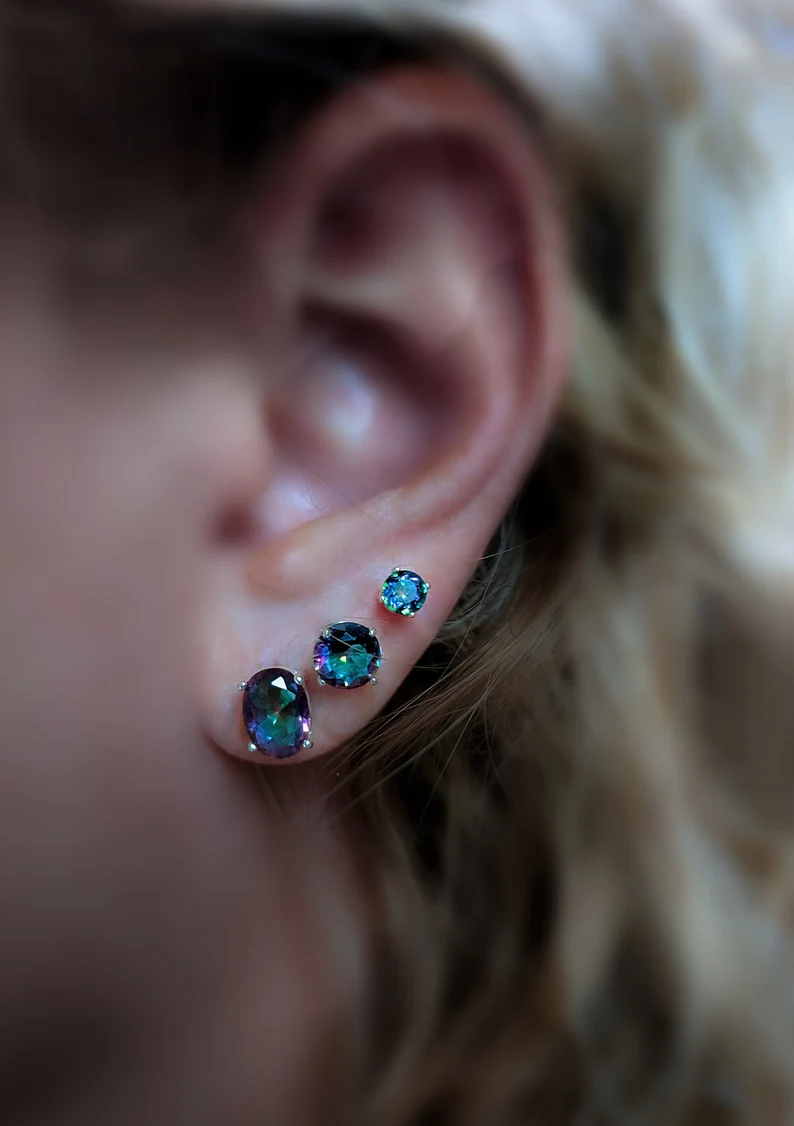
Alexandrite, the most well-known member of the chrysoberyl mineral family, stands out for its simple chemistry as an aluminate of beryl. Unlike its yellow or green counterparts, which absorb little light, alexandrite absorbs light due to its unique crystalline structure.
This absorption is enhanced by a small number of chromium ions replacing some of the crystal’s regular elements, intensifying the absorption of yellow light.
This chromium addition allows alexandrite to reflect green or red light, leading to its color-changing ability known as the Alexandrite Effect. This effect shifts the stone’s color from greenish to reddish depending on the viewing conditions.
The color change isn’t due to a chemical reaction in the chromium but rather a physiological reaction in human vision. In daylight, where all visible light colors are present, our eyes, being more sensitive to green, perceive the stone as green. However, under artificial light, which emits less green and blue light, the stone appears more red.
The 4 C’s of Alexandrite
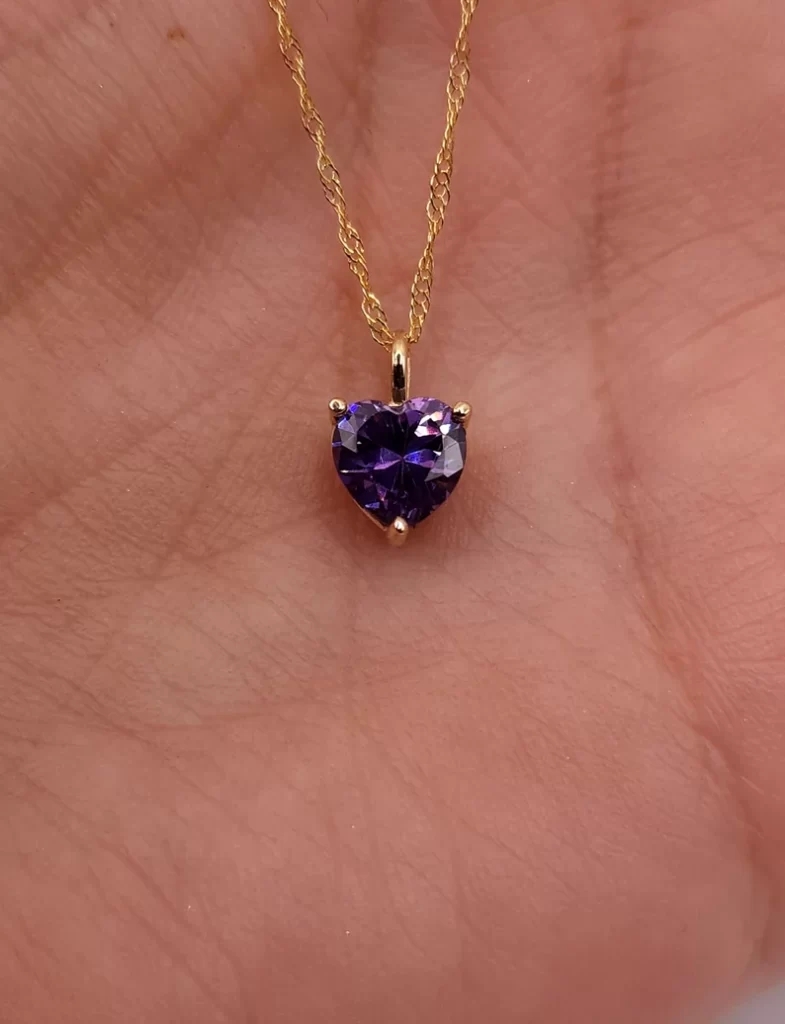
The 4Cs of alexandrite, like other gems, include Color, Clarity, Cut, and Carat. Color is most important, as alexandrite is valued for changing from green to red. Clarity refers to how clear the stone is, with fewer inclusions meaning more value. The Cut is key to bringing out alexandrite’s color change and shine. Carat, the gemstone’s weight, also impacts its value; larger, high-quality alexandrites are rare and thus more prized.
1. Evaluating Alexandrite Clarity
It’s critical to evaluate the clarity of alexandrite to ensure that there are no visible inclusions in the stone.
For alexandrite gems, clarity matters less than the effect of its color (which we will discuss in detail below). What makes these stones valuable is their ability to change color.
So, an alexandrite that has a 100 percent change from green to red is more valuable than an eye clean piece with only slight color change. While clarity is important, it takes second place to color.
2. Evaluating Alexandrite Cut
As with any gemstone exhibiting pleochroism, alexandrite poses a challenge to cutters. They have to ensure that both colors of the stone will appear face up when illuminated.
Alexandrite is typically cut into shapes known as mixed cuts. These contain brilliant cut crowns and step-cut pavilions.
For alexandrite with many flaws and inclusions, the cat’s eye cabochon makes for a good cut. This type of cut exhibits the alexandrite’s beautiful reflection of light coming from the cat’s eye effect.
3. Evaluating Alexandrite Carat Weight
As mentioned above, alexandrite is very rare since there are only limited deposits in the world. The largest known Alexandrite originated in Sri Lanka and weighs about 65.7 carats. Most alexandrite on the market doesn’t weigh more than 1 carat.
If you want to purchase an alexandrite but are on a budget, there are two ways to go about it.
First, you can purchase a heavier, larger alexandrite with less color change. That way you have the size but not so much the magical Alexandrite Effect.
Second, you can go for a smaller one that exhibits a larger scale of color difference, compromising size for color change. Remember that the stone’s distinct quality is always the color change.
4. Evaluating Alexandrite Color
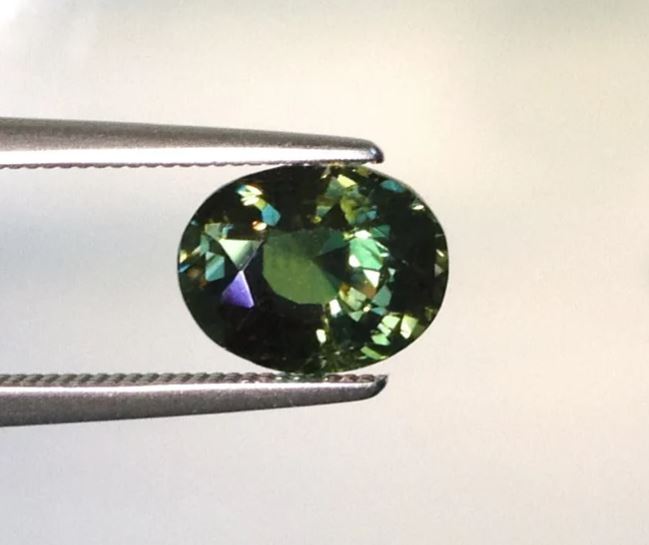
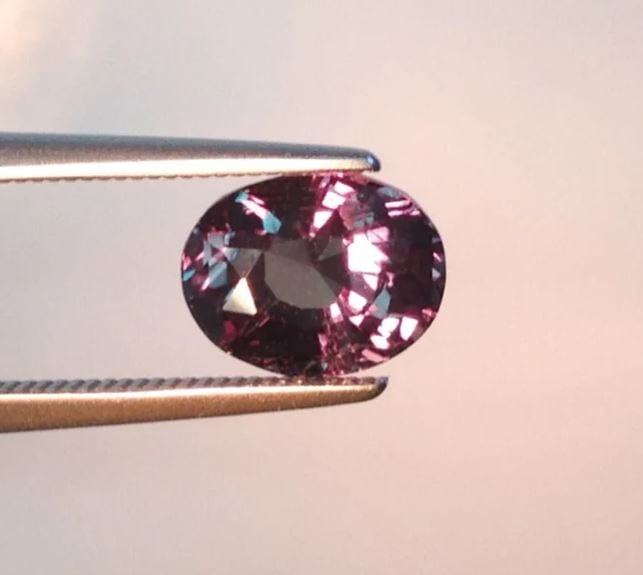
It goes without saying that the most unique and important attribute of an alexandrite is its color. As a rule of thumb, the higher the saturation of a colored stone, the higher the value.
However, in terms of alexandrite, it’s not just the saturation, tone, or hue that affect the value. It is also the extent of the color change. The stronger the dual colors are, the more valuable the stone becomes.
It is important to identify whether your stone is just a color-changing chrysoberyl or a true alexandrite. The table below from gemsociety.org shows the accepted color ranges for a chrysoberyl to be classified as an alexandrite.
Note that the capital letters in the color description point out the dominant color of the colors listed. Other colors, especially yellow, may fall just under color-changing chrysoberyl.
| Daylight (Sunlight) | Incandescent light |
| blue Green | orange Red |
| very slightly blue Green | Red |
| Green | slightly purple Red |
| slightly Green | Purple Red |
| yellow Green | Red purple or Purple red |
If your stone exhibits any of the two corresponding colors in the table, then it probably is an alexandrite and not merely a color-changing chrysoberyl.
Is Alexandrite Valuable?
Alexandrite is a very special and rare gemstone that changes color. Its unique feature, its color, is caused by its special chemical makeup, is the main reason why it’s so valuable. The stronger and clearer this color change, the more the stone is worth.
The size of the Alexandrite is also really important. Bigger stones are much rarer, so they are a lot more expensive. If the stone is clear with few internal marks, known as inclusions, it adds to its value. The way the stone is cut can also make its color change look better and increase its worth.
Because Alexandrite is rare and in high demand, it’s one of the most costly gemstones, sometimes costing thousands of dollars per carat. There aren’t many new sources of high-quality Alexandrite, which makes it even more sought after by collectors and investors.
Is There Synthetic Alexandrite?
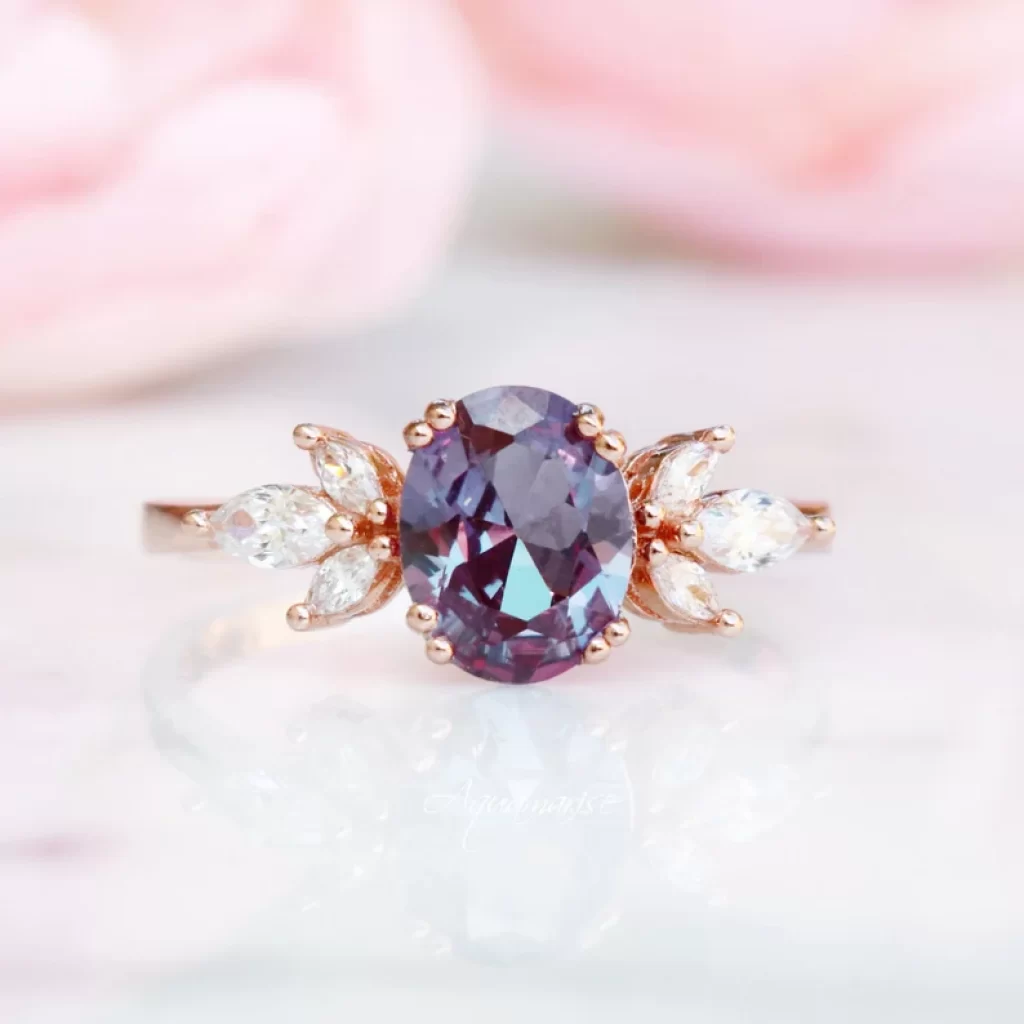
Synthetic Alexandrite is a lab-made gemstone that looks and acts like the natural kind but is created by people. It started being made in the 1960s and is liked because it’s cheaper and has good quality. Like real Alexandrite, it changes color from green to red, but this change can be stronger in the synthetic version. To make synthetic
Alexandrite, scientists use special methods like the flux-melt or hydrothermal methods. These methods speed up what happens in nature, making these stones quickly in a lab. These man-made Alexandrites are a good, less expensive choice for those who love the gemstone but can’t afford the natural, pricier type.
It’s important for shoppers to know the difference between natural and synthetic Alexandrite, as this affects the stone’s value and cost.
Alexandrite Imitations to Watch Out For
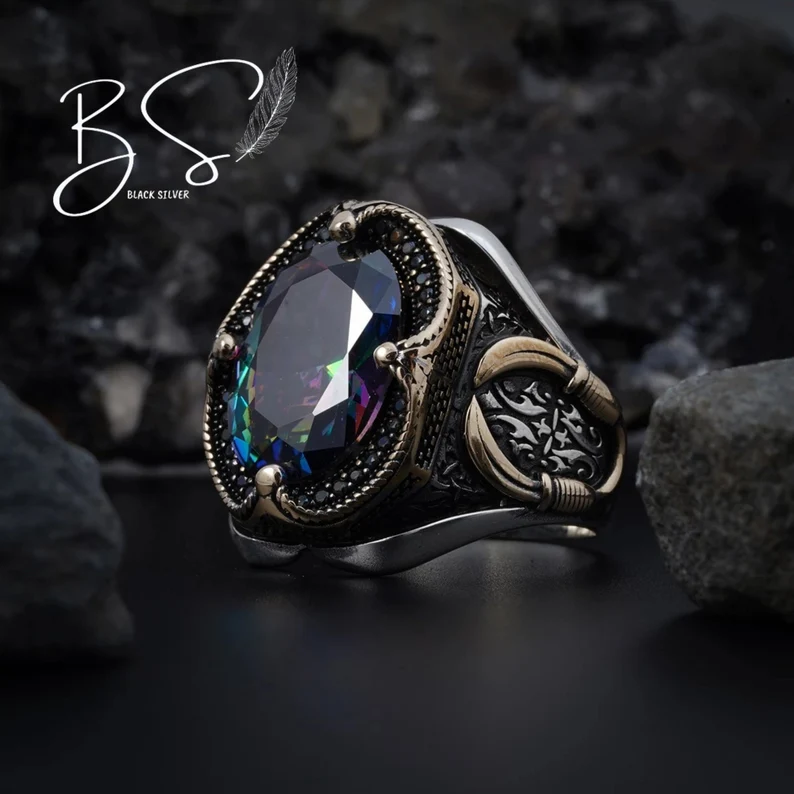
When looking at Alexandrite, it’s key to know about the fake versions out there. The most common fakes are made of synthetic corundum, glass, or plastic. Synthetic corundum is made to look like Alexandrite by adding vanadium to sapphire, but it usually changes from purple to mauve, not green to red like real Alexandrite. Its chemical makeup and light-bending properties are different too.
Glass and plastic are cheaper fakes. They’re colored to resemble Alexandrite but are easy to tell apart from the real thing because they are not as hard and have different weight and density.
Other stones like color change garnet and diaspore might be confused with Alexandrite. Garnet changes from bronze to pink, and diaspore goes from yellowish-green to pink or orange in different lights. Their color change is different from Alexandrite’s.
To really know if Alexandrite is real, it needs to be checked carefully for its physical and chemical features, usually by someone with special gem knowledge and tools. It’s wise to get a certificate from a trusted gem lab to be sure about the authenticity of Alexandrite.
Types of Alexandrite Jewelry
Alexandrite is a special gemstone famous for changing color and is very popular in various jewelry styles for different tastes and occasions.
1. Rings
Alexandrite rings are very popular, especially for engagements and weddings because they are unique and rare. These rings come in many designs. Some are simple with just the Alexandrite, while others are more complex with diamonds around it.
The metal of the ring, like platinum or different types of gold, can change how the Alexandrite looks, with some metals making the stone’s colors stand out more.
2. Earrings
Alexandrite earrings can be either simple studs or more fancy dangling ones. Studs usually have two Alexandrite stones that show off their color change. Dangling earrings are more elaborate, often mixed with diamonds or other gemstones for a fancier look.
3. Pendants and Necklaces
Alexandrite pendants can be simple with just one stone or more detailed with a bigger design. Necklaces might have many Alexandrites or a mix with other gemstones, making them look luxurious and attention-grabbing.
4. Bracelets
Alexandrite bracelets, like tennis bracelets with several small stones, are elegant and fancy. Some have bigger, separate Alexandrites, showing off the color change as they move.
5. Custom and Vintage Pieces
You can get custom-made Alexandrite jewelry for something unique, or choose vintage pieces from periods like the Victorian era. These old pieces are valued for their history and unique making style.
Alexandrite Engagement Rings
Alexandrite is an excellent option for a non-traditional engagement ring due to its durability, brilliance, and color change. Even a small alexandrite stone can be eye-catching and stands out on your finger. It’s hard enough for daily wear and exposure, and can be a heirloom piece.
1. Alexandrite Engagement Rings
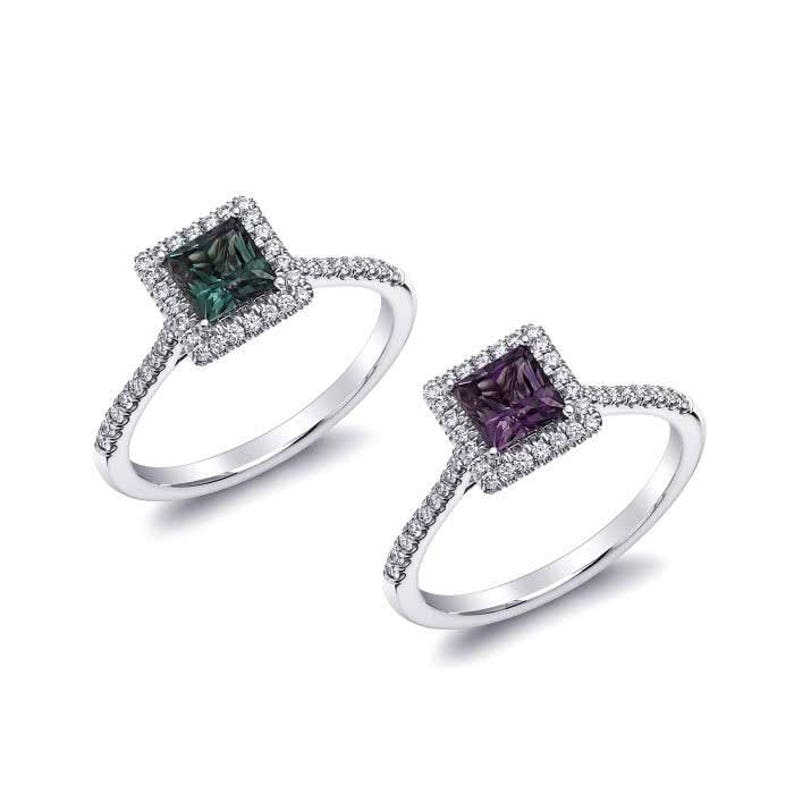
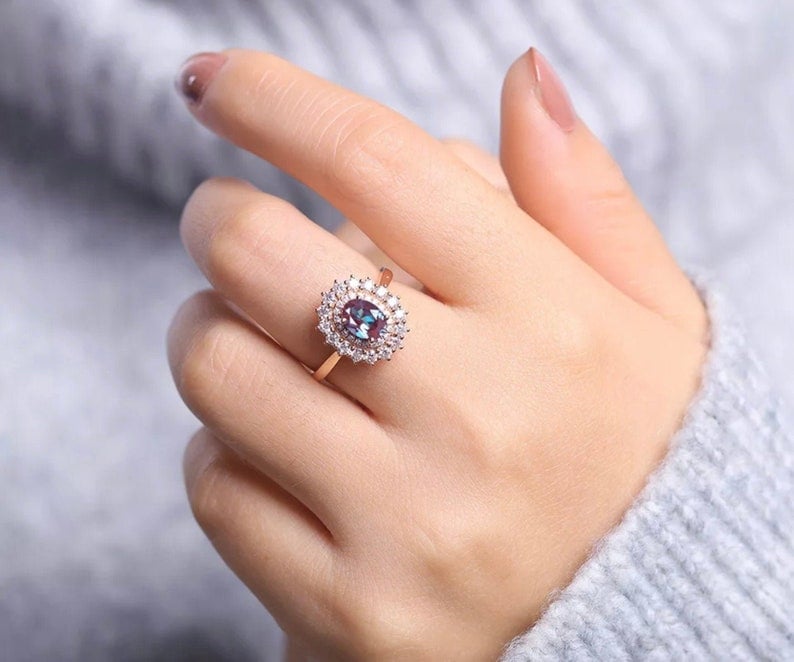
Alexandrite takes center stage in engagement rings with pride. The hints of green and purple complement an array of colors, meaning that your ring will suit any outfit you wear.
While alexandrite goes well with any metal color, rose or yellow gold gives a classic, vintage look to the stone. They’re the most popular metal colors for ring settings for alexandrite. White gold (or white metals such as palladium or platinum) gives a modern look to alexandrite.
Ensure that the metal of the setting is hard enough to hold the alexandrite – we recommend gold, platinum, or palladium.
2. Alexandrite Claddagh Rings
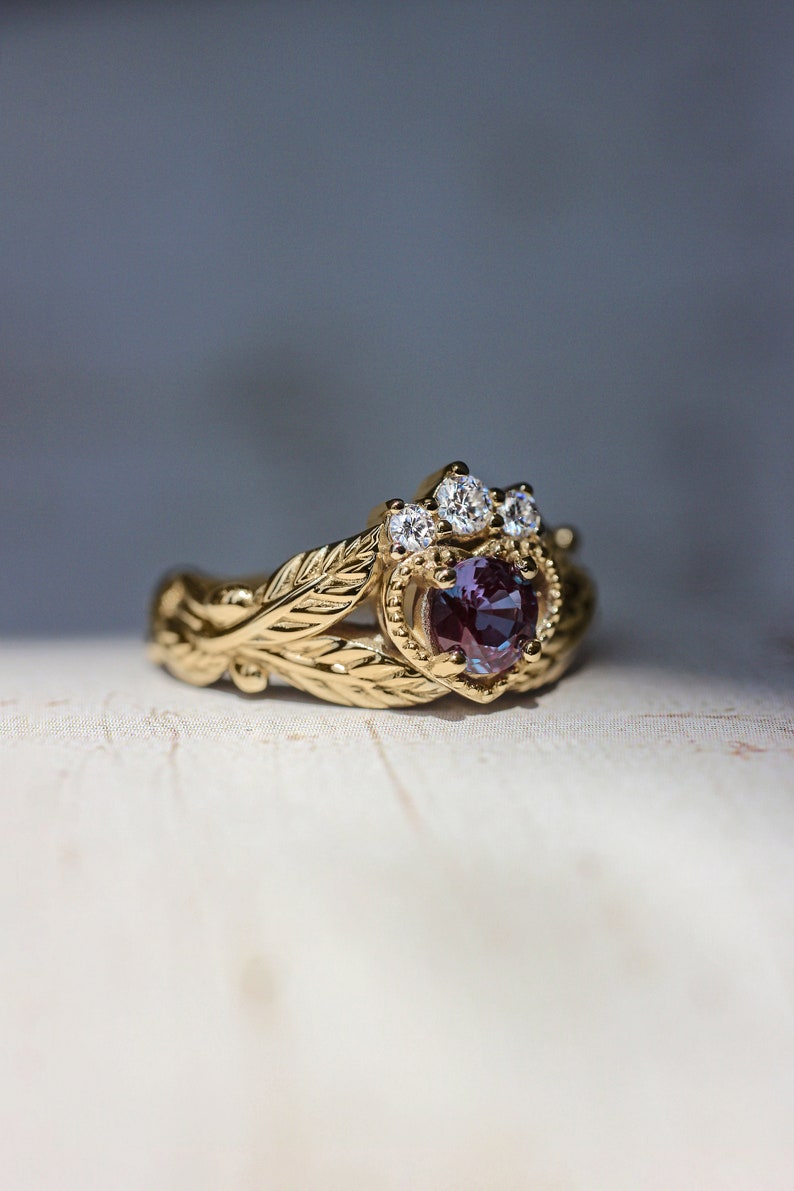
Claddagh rings are a perfect gift for a loved one, whether it be a promise ring or an engagement ring. This is a traditional Celtic design where two hands combine to hold a heart on which rests a crown.
The hands represent friendship, the heart symbolises love and the crown stands for loyalty. What better way to express your feelings than with this meaning-packed symbol.
3. Alexandrite Birthstone Rings
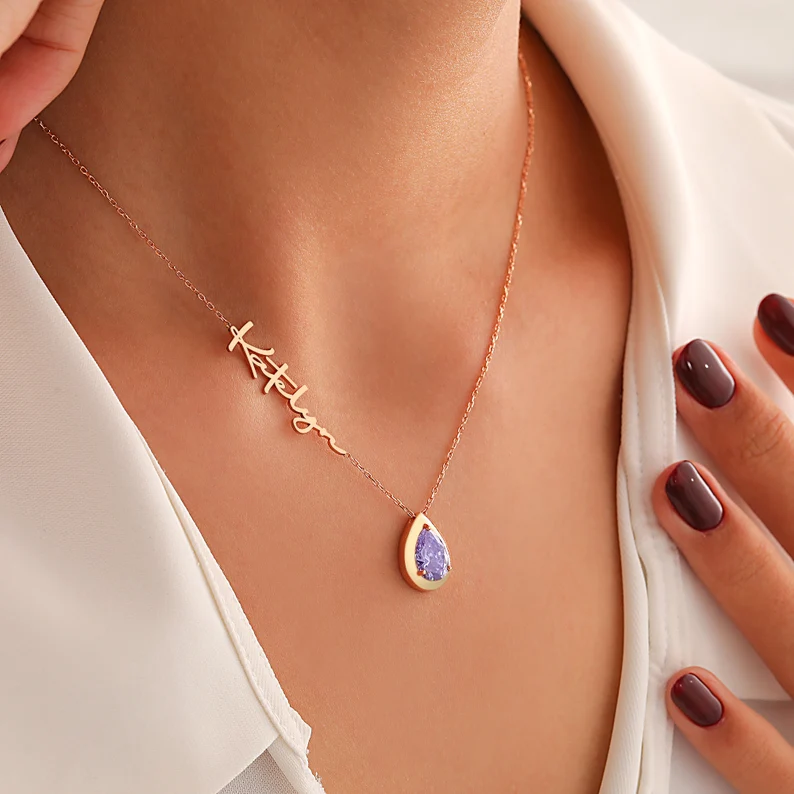
Alexandrite is the birthstone for June (it shares this honor with pearls). If you are a June baby, you might want to consider an alexandrite birthstone ring.
There are several style options for birthstone rings, but most people choose dainty, smaller ring designs for regular wear.
4. Alexandrite Anniversary Rings
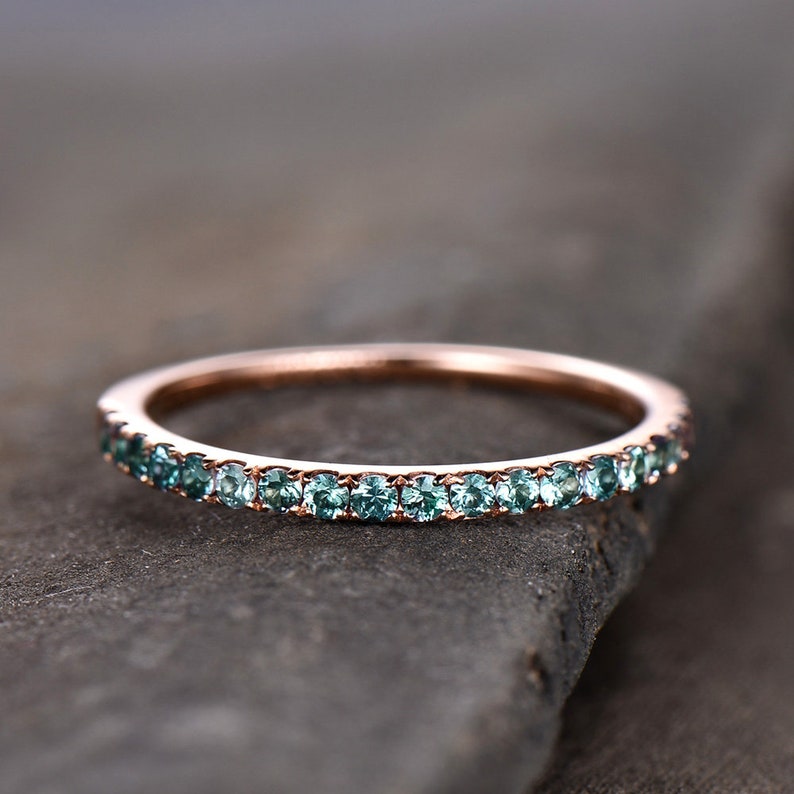
If you are one of those very few lucky people who are celebrating a 55th year of marriage, Alexandrite is the gemstone that represents that special milestone.
There are unique settings that go beautifully with alexandrite, giving you endless options. As a gemstone that looks great on everyone, there is a wide range of masculine and stately alexandrite rings available on the market for men as well.
How to Take Care of Your Alexandrite Jewelry
Alexandrite ranks at 8.5 on the Moh’s scale of hardness, which means that it’s highly resistant to scratches and damage. It’s suitable for daily wear and exposure.
Regular polishing is a good idea, as it removes dust and any residue on the surface that can affect its luster.
When your alexandrite jewelry is dirty, simply using soap, warm water, and a soft brush or soft cloth to wash it is enough to restore its luster. Wash it gently and make sure to rinse the soap away properly.
Because of their hardness, they are safe to be used in ultrasonic cleaners. Avoid exposure to bleach or other harsh chemicals. It’s advised to remove alexandrite when doing strenuous activities with your hands.
While there is no special care required for alexandrite stones, storage might be a problem as softer stones may be easily scratched or scraped by the alexandrite. Wrapping alexandrite in a soft cloth before storing prevents it from damaging other stones and keeps it safe from harder materials like diamonds or sapphires.
What Does Alexandrite Symbolize?
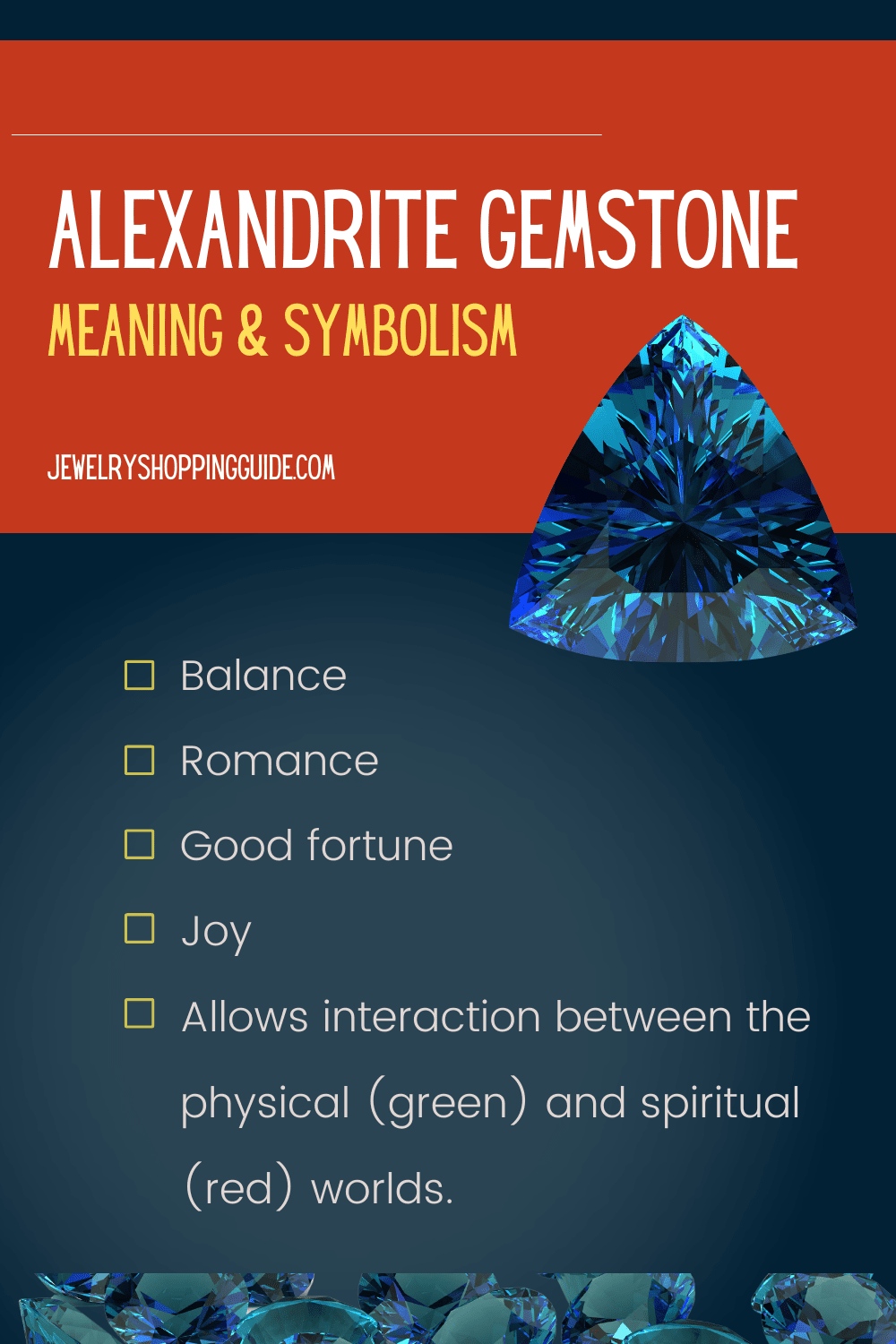
Alexandrite is considered a lucky stone, and represents luck, good fortune, and intellect. Because of alexandrite’s ability to change from green to red, it’s often associated with balance.
It’s believed that an alexandrite allows interaction between the physical world (green) and the spiritual world (red), from which its healing powers come.
By bridging the gap between a person’s body and spirit, alexandrite can alter the flow of the chakra in the wearer’s body to give room for strength, peace, and self-confidence.
The stone is ideal for people who need physical healing, including those who need surgery, have neurological disorders, or are experiencing a coma, where the person’s mind is believed to be detached from the body.
In ancient Russia, where the first alexandrite stone was discovered, alexandrite is thought to bring good fortune and romance, and the balance of joy from tangible and intangible things.
It allows you to appreciate the world around you while reminding you of your purpose in the world.
Where Can I Buy Alexandrite Jewelry?
Alexandrite’s rarity and high value can make finding one at your local store difficult. By taking your search online, you will have more options and competitive prices.
However, if buying online, ensure that you are buying from a top-rated vendor with a proven track record. Most jewelry retailers don’t offer alexandrite jewelry, and most alexandrite on the market is synthetic.
We recommend starting your search on Etsy and Amazon as these platforms have options to suit various budgets and styles.
- Etsy has a range of alexandrite and synthetic alexandrite jewelry on offer, from incredibly valuable antiques to synthetic jewelry that costs just a few dollars.
- Amazon is one of the biggest online retailers worldwide, so it’s not surprising that you can find all kinds of alexandrite jewelry here. The range is extensive.
Of course, since every vendor on Etsy and Amazon have their own policies and rules, do your due diligence. Search for stores with good after sales policies, customer service, and reviews. If purchasing authentic alexandrite, ask for an authenticity certificate.
Wrapping Up
Alexandrite is a remarkable gemstone known for changing colors, making it a standout choice in jewelry. This gemstone is stunning in various forms like rings, earrings, pendants, and bracelets, adding a unique and rare quality to jewelry collections.
Its combination of beauty, scarcity, and rich history makes it a favorite for anyone looking for something special. When picking Alexandrite jewelry, it’s not just about how it looks, but also the unique story behind each piece.


